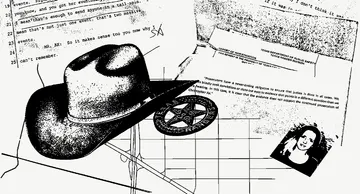BEACON, N.Y. — The way the prison guards described it in their paperwork, there was a minor disturbance the day they took Chad Stanbro to a dental clinic at a regional hospital.
Stanbro, a prisoner, had been sedated but became agitated during surgery, took a swing at a dentist and kicked a correctional officer in the stomach, they wrote. The guard and a colleague had quickly restrained him and had driven him back to Fishkill Correctional Facility, where, according to the senior officer’s account, Stanbro had “reported no injuries.”
But critical details were missing — including that Stanbro had been paralyzed during the incident. A third officer had rushed into the clinic’s operating room and had knelt on Stanbro’s neck until he couldn’t move, according to later court testimony. That guard had asked his colleagues to leave him out of their reports, they acknowledged at trial, and they had done so.
Even though Stanbro’s injuries were obvious — he could not walk or move his body from the neck down — the officer who injured him avoided discipline. Stanbro, however, was accused of assault, and after he left the hospital was put in solitary confinement. In July, a federal jury awarded him $2.1 million in damages.
Such cover-ups are commonplace across New York State’s prison system, according to a Marshall Project review of thousands of pages of court documents, arbitration records and officer disciplinary data.
At Auburn Correctional Facility, west of Syracuse, guards kicked a man, called him a racial slur and broke three of his ribs in what a judge called a “barbaric assault.” At Elmira Correctional Facility, near the Pennsylvania border, officers beat a handcuffed man and threw him down a flight of stairs, fracturing his skull. At Clinton Correctional Facility, near the Canadian border, guards kicked and punched a handcuffed man, breaking his rib. In all three cases, the staff members filed false reports to cover up the assaults, court records show, and faced no discipline.
The records illustrate how cover-ups can make it difficult to hold officers accountable for using excessive force. They also reveal a typical playbook: Guards often work in groups to conceal violent assaults by lying to investigators and on official reports, and then they file charges against their victims and have them sent to solitary.
The Marshall Project obtained disciplinary data on more than 290 cases in which the corrections department tried to fire guards or supervisors accused of abusing prisoners. In nearly three-quarters of those cases, the agency also accused the officers of covering up misconduct, often by acting in concert. The department tried to discipline guards for incidents in which one or more were accused of committing abuse while others lied to hide it, bringing a case, on average, every two months over 12 years.
Few of the accused officers were fired, though many were suspended from their jobs for several months.
The Marshall Project found and analyzed lawsuits involving excessive-force incidents that the state lost or settled in the decade ending in 2020. The department did not try to discipline officers in 88% of the lawsuits, including some in which prisoners were permanently injured or even killed.
Half of the roughly 160 lawsuits complain of guards retaliating against the incarcerated people they injured. A man at Sullivan Correctional Facility said guards beat his head against the floor and smashed his face with handcuffs. At Sing Sing Correctional Facility, officers fractured a man’s eye socket. In both cases, corrections employees charged the men with assault and sent them to solitary. The state paid a total of $56,500 to settle the two lawsuits, but it did not discipline any of the officers involved, saying investigators could not verify the allegations.
Daniel F. Martuscello III, the executive deputy commissioner of the New York State Department of Corrections and Community Supervision, would not discuss individual cases, but he said he was not surprised that false reports often accompany instances of excessive force.
“There has to be some manipulation of facts,” he said.
Michael Powers, president of the New York State Correctional Officers and Police Benevolent Association, did not respond to questions about cover-ups.
“Of the thousands of routine daily interactions between the incarcerated community and correction officers who maintain the safety and security of everyone who works or resides in prison,” he said in a statement, “the extremely small percentage of bad actors who have been afforded due process and are found responsible for wrongdoing should be held accountable for their actions.”
A former New York corrections commissioner, Brian Fischer, called the culture of officers covering up one another’s misconduct the “blue wall” — and said it is deeply rooted in the workplace.
“Just like cops on the street, you depend on the guy watching your back,” Fischer said. “So if he does something stupid, and he comes up and says, ‘Look, I need you to change the report a little bit,’ you’re kind of put in a tough situation.”
In March 2020, Officer Aaron Finn handcuffed a prisoner at Green Haven Correctional Facility and repeatedly smashed his head into a wall and steel bars.
A body camera worn by Finn captured the attack, which left the prisoner, Melvin Virgil, limp and unconscious. Footage from another body camera shows a sergeant repeatedly demanding, “Who applied handcuffs?” and then “Nobody knows nothing now?” as a group of officers stand silently.
Finn filed six misconduct charges that day against Virgil, who went straight to solitary confinement. The guard claimed in his paperwork that he had hit Virgil once after the prisoner had smashed one of his fingers with the handcuffs. Another guard wrote that Virgil had tried to kick the officers even after he was on the ground. Two other officers involved, including the sergeant who had earlier demanded answers, filed similar reports.
But the videos show Finn smashing Virgil’s head into the wall twice before taking him to the ground and ramming his head into the steel bars four times. At the moment when the officers claimed Virgil kicked at them, the video shows him losing consciousness.
Weeks after the assault, investigators showed the video to two officers and gave them a chance to amend their reports. They declined. Corrections officials moved to fire Finn, but did not file disciplinary charges against the other officers.
Finn resigned a year after the attack. In an unusual turn of events, he was later arrested in connection with the assault. He pleaded guilty, and in November was sentenced to three months in federal prison. He did not respond to requests for comment.
Virgil, who was serving a sentence for sexual abuse, robbery and assault, sued Finn and his colleagues last year. The guards have denied the allegations and asked a judge to dismiss the case.
Another prisoner had accused Finn of a similar attack in 2015, when he said the guard handcuffed him and smashed his head into a wall. Last year, the state paid $9,500 to settle that case.
A comprehensive look at cases like Virgil’s, in which guards appear to conspire to cover up violent incidents, was not possible until recently. New York required all discipline records for prison guards and police officers to be kept secret. But the Legislature changed the law in 2020, allowing The Marshall Project to obtain thousands of discipline records detailing allegations of misconduct inside prisons.
The records show that even when the corrections department attempted to fire officers for excessive force or for lying about it, the agency succeeded just 10 percent of the time.
The officers’ efforts to conceal the violent episode that paralyzed Stanbro were complicated by a major factor: The incident happened in a public hospital rather than an isolated prison.
Guards from Fishkill, where Stanbro was serving a 10-year sentence for stealing a television and violating parole, drove him to a dental clinic for prisoners in August 2018. During a procedure to treat a dislocated jaw, he became agitated, tried to pull away and knocked over a monitor, according to court records. When he regained full consciousness, he later testified, a third officer, Kristofer Leonardo, was pressing a knee into his neck as the other guards held him down. The force on Stanbro’s spine paralyzed him, medical and court records show.
Afterward, the other guards would testify, Leonardo asked them for a favor: Keep his name out of their official reports.
“He was an officer that I respected,” Officer Nadya Palou told the jury, explaining why she went along with the request.
After Leonardo left the hospital, a security camera in the parking lot captured Palou and a colleague lifting Stanbro’s limp body into a van to drive back to Fishkill. They stopped along the way to prop him up, Palou later testified.
Before the officers returned to Fishkill, hospital staff had already called the prison to complain about the use of force, a corrections supervisor testified.
The guards who drove Stanbro wrote in their official reports that he had climbed into the van himself — they did not realize there was video showing otherwise. As requested, neither mentioned Leonardo in their reports.
In the prison infirmary, a nurse and a captain accused Stanbro of faking his injuries, he testified. It was only after the nurse repeatedly poked his feet with a needle and got no response that the staff members called for an ambulance.
A helicopter took Stanbro back to Westchester Medical Center, the same hospital where Leonardo had knelt on his neck. Doctors diagnosed quadriplegia and operated on his spine. He spent 12 days there.
Leonardo, who had been escorting men from a different prison to the dental clinic, did not report that he had used force on Stanbro. His supervisor at Greene Correctional Facility later learned of an internal investigation and ordered the guard to fill out the required paperwork. Leonardo wrote that he wrapped Stanbro in a bear hug and helped handcuff him after Stanbro had punched a guard. In court, Leonardo denied both the assault and the request that his name be left out of the reports.
The guards’ stories fell apart at trial. In a rare concession, two officers admitted to jurors they had lied, first by omitting Leonardo from their reports and then by saying Stanbro had walked himself to the van. The dentist testified that Stanbro had never tried to punch him or the guards.
State officials did not try to punish Leonardo. The agency said Palou resigned while disciplinary charges were pending, and the third officer was fined $3,000. None of the officers responded to several requests for comment.
While guards regularly suffer no consequences for using excessive force on incarcerated people, the prisoners often leave the encounters not only injured, but also facing administrative hearings that can lead to harsh penalties. After Stanbro was discharged from the hospital, the guards accused him of assault. He was given 40 days in solitary confinement. Still paralyzed, he was allowed to leave his cell once a day for physical therapy, he later testified.
Several lawyers, advocates and former correctional managers said it is common practice for corrections employees to beat prisoners and then charge them with assault, even when the prisoners have suffered grievous injuries as Stanbro did.
Guards at Adirondack Correctional Facility, west of Lake Placid, beat a man and fractured his rib. And a beating by officers at Southport Correctional Facility, which closed last year, left a man with permanent damage to his shoulder and eye. In both cases, employees accused the men of assaulting them — and supervisors put the prisoners in solitary confinement. Both prisoners got the rulings reversed on appeal. They later sued and received six-figure settlements. Two Southport officers were suspended for a year for their actions. None of the guards were fired.
Attacks by guards are almost certainly more common than the discipline records indicate, experts said. Officers exert an enormous amount of control over prisoners’ lives, which deters incarcerated people from reporting abuse, said Jennifer Scaife, executive director of the Correctional Association of New York, a nonprofit prison monitoring group. Scaife said she often hears from people who say they are being mistreated but are afraid that reporting it will cause guards to turn on them.
“It’s like, ‘Oh, you want to do that to us? Watch all the ways we can make your life a living hell,’” she said.
Kevin Ryan, a former prison investigator in New York, found the cover-up culture among guards and indifference from top managers so effective at thwarting his investigations that he eventually quit.
“At some point, it just becomes a waste of time because nobody is going to tell you the truth,” said Ryan, who was a federal customs agent for 25 years before joining the corrections system in 2015.
Ryan pointed to the case of Roy Harriger, who was convicted in 2015 of sexual abuse of a child. Harriger said a guard at Attica Correctional Facility beat him in the back of the head with a baton, leaving him paralyzed. The assault occurred sometime after a guard had picked him up at the sergeant’s office on his cell block, and before he arrived unconscious at the infirmary.
Ryan assigned three investigators to dig through records and interview staff members.
The officers put up a united front, saying they knew nothing or that Harriger had fallen in the shower. Crucial records were missing. About a dozen staff members refused to be interviewed by state police. Ryan said he never determined which guard attacked Harriger. No one was ever disciplined for the assault, and no criminal charges were filed.
Harriger sued. At trial, his lawyer asked the sergeant working in his cell block and the sergeant at the infirmary which officers escorted Harriger that day. Both sergeants testified dozens of times that they didn’t recall and never tried to find out.
The judge said she was appalled: The corrections department, which “requires the completion of paperwork on just about everything that occurs in the prison system, somehow neglected to file any paperwork related to this incident,” she wrote.
Citing the medical records, the judge ruled in November 2020 that the Attica staff’s story that Harriger had fallen in the shower was a “fabrication.” She awarded him nearly $2.4 million. He has remained in a wheelchair since the attack and can’t straighten the fingers on his right hand, which contract like claws and dig into the flesh of his palm, according to court records.
Such assaults and cover-ups are crimes, Ryan said, and his office referred more than a dozen cases to the State Police and Federal Bureau of Investigation. Those investigations almost never resulted in criminal charges against correctional officers.
The best way to get officers to break their code of silence, Ryan said, would be to pressure them under oath in a federal grand jury, where deceit results in criminal charges like perjury or lying to an FBI agent.
“Then you separate the herd,” Ryan said.
Four years after the neck injury, Stanbro was paroled, but he has struggled since he moved back to live with his family in Elmira. After surgery and months of physical therapy, he can now use his arms and hands. He can walk with a limp and is able to lift only light objects. Nerve pain regularly shoots down his back through his triceps to his fingertips, according to testimony and court records.
“I used to be a big, strong kid,” he said in an interview.
Stanbro had dealt with mental health problems and substance abuse before he was imprisoned; since the assault, anger and depression have consumed him, he said. He landed in jail in February after suffering a psychotic episode.
He has said he is troubled that none of the guards were prosecuted for the assault and cover-up. He was interviewed by the State Police and the Westchester district attorney’s office, which closed the investigation without filing charges.
Stanbro said he is reluctant to wish incarceration on anyone, but he believes that the three officers should go to prison.
“It’s the only thing that anybody seems to be scared of,” he said. “This is not revenge I seek; this is change.”
CREDITS
For The Marshall Project
Reporting by Alysia Santo, Joseph Neff, Tom Meagher and Ilica Mahajan.
Data review by Peter Buffo, Andrew Rodriguez Calderón, Carla Canning, Liset Cruz, David Eads, Ariel Goodman, Geoff Hing, Weihua Li and Ilica Mahajan.
Illustrations by Dion MBD.
Photographs by DeSean McClinton-Holland, Joshua Rashaad McFadden, Heather Ainsworth and Alysia Santo.
Design and development by Bo-Won Keum, Katie Park and Andrew Rodriguez Calderón.
Art direction and photo editing by Bo-Won Keum and Celina Fang.
Copy editing by Ghazala Irshad.
Audience engagement by Ashley Dye.
Engagement reporting by Nicole Lewis.
Editing by Leslie Eaton and Manuel Torres.
For The New York Times
Video by Jeesoo Park.
Photo editing by Jeffrey Furticella.
Copy editing by Ellen Tumposky.
Audience engagement by Jennie Coughlin.
Editing by Michael LaForgia and Kirsten Danis.



